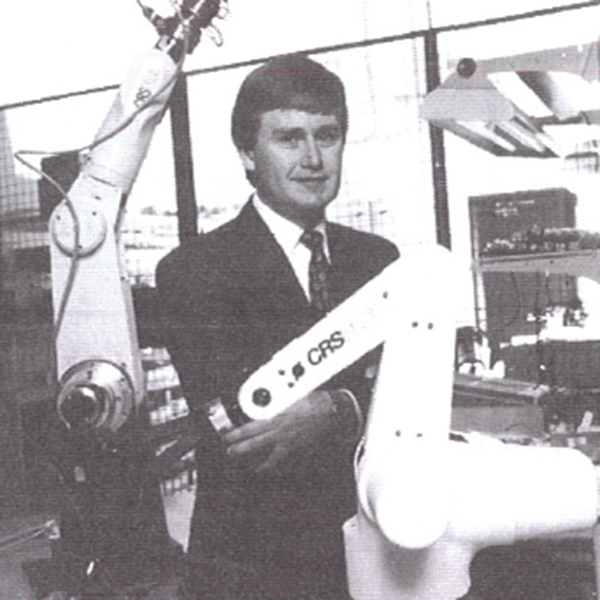
Alumni Spotlight

Alumni Spotlight
Raymond Simmons had a serious case of the jitters when he flew to Japan in 1988 to sell his midget robots. After all, the Japanese dominate the world in high technology. But the Japanese were so impressed by the robot they bought 14.
“At that point, we knew we were in the big leagues,” says Simmons, co-owner of CRS Plus Inc. of Burlington. “We were ready to take on the world.”
Customers in other industrial nations, including Germany and the U.S., have been equally dazzled by Simmons’ robotic arm. Last year, CRS Plus sold $2.5 million worth of them at $20,000 a piece and racked up a profit of $315,000.
Simmons, 32, and his three partners put several years into developing the robot with little help from others.
In fact, when Simmons first approached the banks and the federal government for funding in 1982, they told him to forget it. They weren’t about to throw money into a wild-eyed scheme to build fancy robots, especially since Simmons and his brainy friends had little cash of their own and few contacts in the manufacturing industry.
“A lot of people in Canada told us we would fold,” says Simmons, “but we were young and we didn’t listen.”
Fresh out of Hamilton’s Mohawk College in the late 70’s, Electronics grad Simmons started selling parts for a computer company. On his rounds, he bumped into three robotics engineers from McMaster University and decided to create their own company and produce a smaller robot – about the size of a human arm – that would sell for $10,000 to $20,000. The lower price would make automation affordable to large and small businesses alike.
“We found a gap in the marketplace,” says Simmons “and we decided to fill it.”
Rejected by the banks and the government, the foursome scraped up enough money from their savings to open a shop in Toronto and cobbled together a unique piece of technology.
CRS’s robots work alongside people, eliminating only the dangerous or tedious jobs that people don’t want to do such as handling deadly laboratory samples. Laceburg manufacturing company approached the management to buy a robot so that employees wouldn’t have to dip metal faucets into molten plastic.
“Our robot does it now,” says Simmons. “Unlike a human, it’s not bothered by the fumes, or the splashing of plastic that’s 350 degrees hot.”
CRS scored its first breakthrough in 1985, when it sold a robot to the Hospital for Sick Children in Toronto, for $12,000. It’s used there for handling specimens in the laboratory. The device worked so well the hospital bought several more and now sells them for CRS to other hospitals through a small company it spun off.
Even the banks changed their tune after CRS showed a few years of solid sales and growth and Simmons now has a $300,000 line of credit.
Today, CRS turns out three different robotic arms, each progressively faster and more flexible in the joints. Like the human arm, industrial robots have elbow and wrist joints that bend and twist. The robots are programmed for various tasks using personal computers.
“Many people gladly pay the extra money to get the higher performance,” Simmons says. “It still amazes me that we can beat out the Japanese in their own country.”
While CRS started in Toronto, it later moved to neighbouring Burlington, to avoid the traffic problems, says Simmons. There are now 25 employees.
This story was originally published in the Summer 1991 edition of the Mohawk Alumni In Touch magazine.
When Témo Cruz enrolled in Mohawk College’s Architectural Technology Program, he never imagined it would introduce him to the world of shipping con
Mohawk alumnus Greg Gagnon has “it”. Expertise, character and passion that have led to two high esteemed awards.
After graduating from Mohawk College's Recreation and Leisure program, the world called, and Iuliana Raducanu answered.